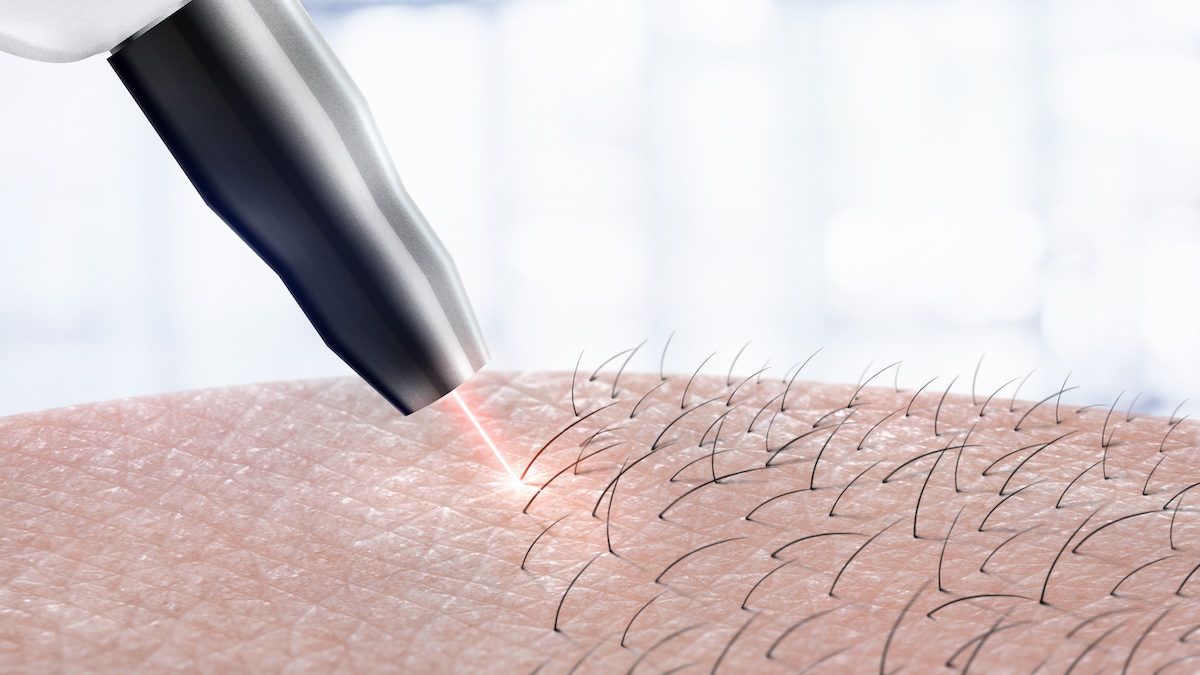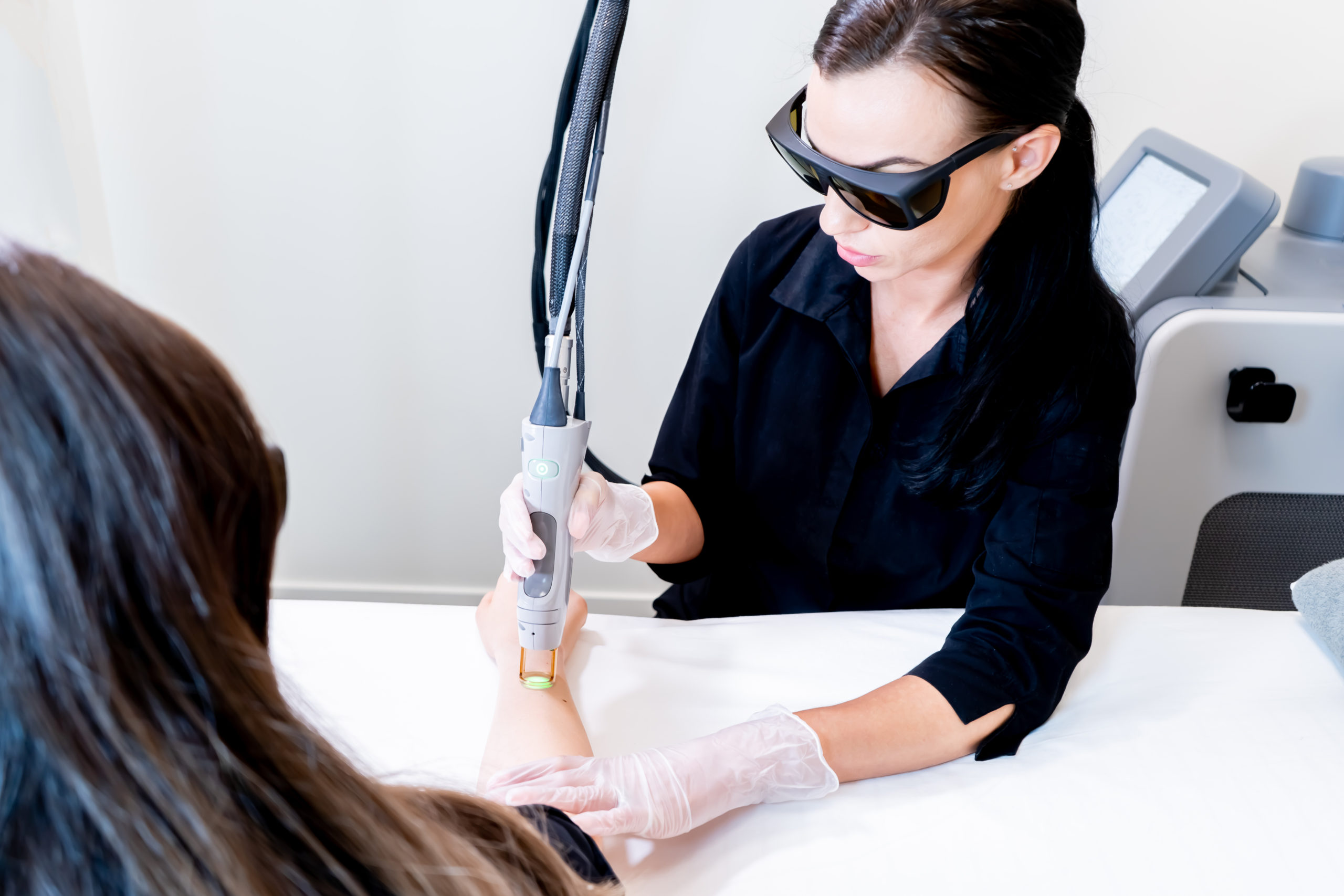Home>FAQs>How Often Do You Get Laser Hair Removal Treatments


FAQs
How Often Do You Get Laser Hair Removal Treatments
Modified: August 5, 2023
Find answers to all your general questions about laser hair removal treatments. Learn how often you should get laser hair removal treatments for optimal results.
(Many of the links in this article redirect to a specific reviewed product. Your purchase of these products through affiliate links helps to generate commission for Under-tec.com, at no extra cost. Learn more)
Table of Contents
- Introduction
- Understanding Laser Hair Removal
- Factors Affecting the Frequency of Laser Hair Removal Treatments
- Recommended Time Gap between Laser Hair Removal Sessions
- Individual Hair Growth Cycles and Treatment Frequency
- Commonly Treated Areas and Their Recommended Treatment Intervals
- Maintenance Sessions and Long-Term Results
- Conclusion
Introduction
Welcome to the world of laser hair removal, a revolutionary method of getting rid of unwanted hair. If you’re tired of the hassle of shaving, waxing, or using depilatory creams, laser hair removal can be a game-changer for you. But how often do you need to go for laser hair removal treatments to achieve optimal results?
Laser hair removal is a cosmetic procedure that uses concentrated beams of laser light to target the hair follicles, disabling their ability to produce new hair. It offers a more permanent solution compared to traditional hair removal methods. However, to achieve long-term hair reduction, multiple sessions are usually required. The frequency of these sessions depends on various factors, including your hair growth pattern, the area being treated, and the desired outcome.
Before delving into the frequency of laser hair removal treatments, it’s important to understand how the procedure works. During a session, a laser device emits a concentrated beam of light that is attracted to the pigment (color) in your hair follicles. The light energy is then converted to heat, which damages the follicles and inhibits future hair growth.
While laser hair removal is an effective method, it’s important to note that it may not result in 100% permanent hair removal. Most individuals experience a significant reduction in hair growth, with some hairs becoming finer and lighter in color. As a result, maintenance sessions may be required to sustain the desired hair-free outcome.
Now that we’ve established the basics, let’s explore the factors that influence the frequency of laser hair removal treatments. Understanding these factors will help you determine the recommended time gaps between sessions and achieve optimal results.
Understanding Laser Hair Removal
Laser hair removal is a popular cosmetic procedure that offers a long-term solution for getting rid of unwanted hair. Unlike temporary hair removal methods like shaving or waxing, laser hair removal targets the hair follicles directly, inhibiting their ability to produce new hair.
The procedure works by using a laser device that emits a concentrated beam of light. This light is attracted to the pigment in the hair follicles, heating them up and damaging them in the process. The heat generated by the laser also affects the surrounding skin, but modern laser technology is designed to minimize any potential skin damage.
One of the key advantages of laser hair removal is that it can be performed on various parts of the body, including the face, underarms, arms, legs, bikini area, and back. However, it’s important to note that the effectiveness of laser hair removal can vary depending on factors such as hair color and skin type.
Dark, coarse hair tends to respond better to laser hair removal than light, fine hair. This is because the laser targets the pigment in the hair follicles, so the more contrast between the hair color and the skin color, the more effective the treatment is likely to be. As for skin types, individuals with lighter skin tones and darker hair typically see the best results.
It’s worth noting that laser hair removal may not be suitable for everyone. Individuals with certain medical conditions, such as skin disorders or hormonal imbalances, may not be eligible for the procedure. Additionally, pregnant women are usually advised to postpone laser hair removal until after they give birth.
It’s also important to have realistic expectations about the outcome of laser hair removal. While many individuals experience a significant reduction in hair growth, it’s unlikely to result in 100% permanent hair removal. Most people will require multiple sessions to achieve the desired results, and occasional maintenance sessions may be needed to sustain the effects over time.
Now that we have a clear understanding of how laser hair removal works, let’s explore the factors that can affect the frequency of treatments.
Factors Affecting the Frequency of Laser Hair Removal Treatments
The frequency of laser hair removal treatments varies from person to person and is influenced by several factors. Understanding these factors can help you determine the optimal time gaps between sessions and achieve the best possible results. Let’s take a closer look at the factors that affect treatment frequency:
1. Hair Growth Cycle: The hair growth cycle is an important factor in determining the frequency of laser hair removal treatments. Hair grows in three phases – anagen (active growth), catagen (transitional), and telogen (resting). Laser hair removal is most effective during the anagen phase when the hair is actively growing. Since not all hair is in the anagen phase at the same time, multiple sessions are necessary to target hair in different growth stages.
2. Hair Color and Thickness: The color and thickness of your hair play a role in treatment frequency. Dark, coarse hair absorbs more laser energy, making it easier to target and remove. Lighter hair colors, such as blonde, red, or gray, may require more sessions as they have less melanin (pigment) to absorb the laser’s energy. Additionally, thicker hair may require additional treatments to ensure complete hair reduction.
3. Skin Type: Your skin type and color can also affect the frequency of laser hair removal treatments. Laser devices target the pigment in the hair follicles, so individuals with lighter skin tones and darker hair typically achieve better results. Darker skin tones have more melanin in the skin, making it more challenging for the laser to distinguish between the hair follicles and the surrounding skin. As a result, specialized laser devices and longer intervals between treatments may be required for darker skin types.
4. Treatment Area: The area being treated also influences the frequency of sessions. Smaller areas such as the upper lip or underarms may require fewer treatments compared to larger areas like the legs or back. This is because smaller areas can be covered in a shorter amount of time, allowing for more frequent treatments if necessary. Conversely, larger areas may require longer intervals between sessions to allow the skin to heal properly.
5. Hormonal Factors: Hormonal imbalances can impact the hair growth cycle, leading to increased hair growth or changes in hair texture. Hormonal conditions such as polycystic ovary syndrome (PCOS) or thyroid disorders may require more frequent laser hair removal treatments to manage the effects of excess hair growth.
6. Desired Outcome: The desired outcome also plays a role in determining the frequency of treatments. Some individuals may be satisfied with a significant reduction in hair growth, while others may want to achieve nearly permanent hair removal. Depending on your goals, the frequency of treatments can be adjusted to maintain the desired level of hair reduction.
By considering these factors and consulting with a qualified professional, you can determine the optimal frequency of laser hair removal treatments for your specific needs. Keep in mind that multiple sessions are usually necessary to achieve the best results, and maintenance sessions may be required to sustain the effects over time.
Recommended Time Gap between Laser Hair Removal Sessions
The time gap between laser hair removal sessions is an essential aspect to consider when planning your treatment schedule. While this can vary depending on individual factors, there are some general guidelines that can help determine the recommended intervals between sessions.
In most cases, laser hair removal treatments are scheduled anywhere from 4 to 8 weeks apart. This interval allows for an effective targeting of the hair follicles while giving the skin enough time to heal between sessions. It’s important to keep in mind that hair grows in cycles, and treating the hair during the anagen (active growth) phase is crucial for optimal results.
By spacing out the sessions approximately 4 to 8 weeks apart, you ensure that you are targeting new hair follicles that have entered the growth phase. Treating the hair at the right stage will result in better hair reduction and decrease the likelihood of regrowth.
However, it’s worth mentioning that the specific time gap between sessions may vary depending on various factors such as the treatment area, hair color, and individual hair growth patterns. Some areas, such as the face or underarms, which have a higher concentration of active hair follicles, may require more frequent sessions than larger areas like the legs or back.
The color and thickness of your hair can also influence the recommended time gap between visits. Dark, coarse hair typically responds better to laser hair removal, so you may be able to schedule treatments on the shorter end of the spectrum. Lighter-colored or finer hair may require longer intervals between sessions to achieve the desired results.
Additionally, it’s important to follow the guidance and recommendations of your laser hair removal specialist. They will assess your specific situation and create a treatment plan tailored to your needs. They may suggest adjustments to the time gap between sessions based on their expertise and your progress.
Remember, laser hair removal is a gradual process, and it’s important to be patient and consistent with your treatments. Following the recommended time gap between sessions will allow the treatment to target hair in different growth stages and provide the best opportunity for long-term hair reduction.
Now that you have an understanding of the recommended time gap between laser hair removal sessions, let’s explore how individual hair growth cycles can influence treatment frequency.
Individual Hair Growth Cycles and Treatment Frequency
Understanding your individual hair growth cycle is crucial for determining the frequency of laser hair removal treatments. Hair growth is not uniform across the body, and different areas may have varying hair growth patterns. By considering your hair growth cycle, you can optimize the timing and effectiveness of your laser hair removal sessions.
As mentioned earlier, hair grows in three phases – anagen, catagen, and telogen. The anagen phase is the active growth phase where the hair follicle is actively producing new hair. This is the ideal phase to target during laser hair removal treatments, as the laser energy is most effective at damaging the follicles and impeding future hair growth.
The length of the anagen phase can vary depending on factors such as genetics, age, and hormonal influences. On average, the anagen phase lasts anywhere from a few months to a few years. However, it’s important to note that not all hairs are in the anagen phase at the same time. This is why multiple laser hair removal sessions are necessary to ensure that all hair follicles are effectively treated during their active growth phase.
The catagen phase is a transitional phase where the hair follicle begins to shrink and detach from the blood supply. The telogen phase, also known as the resting phase, is when the hair follicle is inactive, and the hair strand is ready to shed and be replaced by a new one. During these phases, the hair follicle is not actively producing new hair, making laser hair removal less effective.
Given these hair growth phases, it’s recommended to schedule laser hair removal sessions at intervals that align with the anagen phase of the hair growth cycle. Typically, this means spacing out treatments anywhere from 4 to 8 weeks apart. By doing so, you allow enough time for new hair follicles to enter the anagen phase and be targeted during subsequent sessions.
However, it’s important to note that individual hair growth patterns can vary. Some individuals may have shorter hair growth cycles, while others may have longer ones. The timing of your laser hair removal sessions may need to be adjusted accordingly. Your laser hair removal specialist will assess your specific hair growth cycle and determine the most appropriate treatment frequency for you.
It’s also worth mentioning that certain factors, such as hormonal changes, medications, or medical conditions, can influence hair growth cycles. For example, individuals with hormonal imbalances, like polycystic ovary syndrome (PCOS), may experience prolonged anagen phases and increased hair growth. In such cases, more frequent laser hair removal sessions may be necessary to manage and reduce hair growth effectively.
By understanding your individual hair growth cycle and working closely with a knowledgeable professional, you can optimize the treatment frequency and achieve the best possible results from laser hair removal.
Next, let’s explore the recommended treatment intervals for specific commonly treated areas of the body.
Commonly Treated Areas and Their Recommended Treatment Intervals
Laser hair removal can be performed on various parts of the body, and the recommended treatment intervals may vary depending on the area being treated. Different areas have different hair growth patterns and skin sensitivities, which can influence the frequency of laser hair removal sessions. Here are some commonly treated areas and their recommended treatment intervals:
1. Face: The face is a delicate area that requires careful consideration when it comes to laser hair removal. The recommended treatment interval for facial hair is typically around 4 to 6 weeks. This allows the targeted hair follicles to enter the anagen phase and ensures optimal hair reduction. However, it’s important to be cautious with facial laser hair removal, as the skin on the face is more sensitive than other areas of the body.
2. Underarms: Underarm hair can be bothersome and may require more frequent laser hair removal sessions compared to other areas. The recommended treatment interval for underarms is typically around 4 to 6 weeks. This interval allows for effective targeting of the hair follicles during their active growth phase.
3. Arms and Legs: The arms and legs generally have a slower hair growth rate compared to other areas of the body. Therefore, the recommended treatment interval for the arms and legs is typically around 6 to 8 weeks. This interval allows for sufficient time for the hair follicles to enter the anagen phase and be effectively targeted during subsequent sessions.
4. Bikini Area: The bikini area is a common area for laser hair removal. The recommended treatment interval for the bikini area is typically around 4 to 6 weeks. This allows for optimal hair reduction while allowing the skin to heal between sessions. It’s important to note that laser hair removal in the bikini area should be performed by a trained professional to ensure safety and effectiveness.
5. Back and Chest: The back and chest are larger treatment areas that may require longer intervals between sessions. The recommended treatment interval for the back and chest is typically around 6 to 8 weeks. This interval allows for adequate time for the skin to heal and for new hair follicles to enter the anagen phase for effective targeting.
It’s essential to consult with a qualified laser hair removal specialist before undergoing treatment on specific areas of the body. They will assess your individual hair growth patterns, skin sensitivity, and other factors to determine the most appropriate treatment interval for you.
Remember, consistency is key when it comes to laser hair removal. Following the recommended treatment intervals and completing the recommended number of sessions will help you achieve the best possible results. Additionally, maintenance sessions may be required to sustain the desired hair reduction over time.
Now that we’ve explored the recommended treatment intervals for commonly treated areas, let’s discuss maintenance sessions and long-term results.
Maintenance Sessions and Long-Term Results
While laser hair removal can provide long-term reduction in hair growth, it’s important to understand that it may not result in 100% permanent hair removal. Some hair follicles can be resistant to treatment or may reactivate over time, leading to some regrowth. However, with proper maintenance sessions, you can sustain the desired hair reduction and enjoy long-term results.
Maintenance sessions are typically recommended after the initial series of laser hair removal treatments. These sessions help to target any regrowth and maintain the desired level of hair reduction. The frequency of maintenance sessions varies depending on individual factors, but they are typically scheduled every 6 to 12 months.
During maintenance sessions, the laser targets any new hair follicles that have entered the growth phase. By consistently treating these follicles, you can prevent them from fully regrowing and maintain the desired level of hair reduction. Maintenance sessions also help to ensure that any hair that does regrow comes back finer and lighter in color.
It’s important to follow the recommendations of your laser hair removal specialist regarding the timing and frequency of maintenance sessions. They will assess your specific hair growth patterns, skin sensitivity, and other factors to determine the most appropriate schedule for your maintenance sessions.
In addition to maintenance sessions, there are a few tips you can follow to help prolong the benefits of laser hair removal:
- Avoid sun exposure: Protecting your skin from excessive sun exposure can help maintain the results of laser hair removal. UV rays can stimulate hair follicle growth and make the treatment less effective. Use sunscreen and cover the treated areas when going out in the sun.
- Avoid waxing or plucking: During laser hair removal, the hair follicles are targeted, so it’s important to avoid removing hair from the roots between sessions. Waxing, plucking, or threading can disrupt the hair growth cycle and interfere with the effectiveness of the treatment.
- Maintain a healthy lifestyle: Maintaining a healthy lifestyle can positively impact hair growth and overall skin health. Eating a balanced diet, staying hydrated, and managing stress can help promote optimal hair growth and improve the overall results of laser hair removal.
By following these tips and attending maintenance sessions as recommended, you can enjoy long-term results from laser hair removal. It’s important to have realistic expectations and understand that occasional touch-up sessions may be necessary to maintain the desired level of hair reduction.
Now that we’ve covered maintenance sessions and long-term results, let’s conclude our discussion on laser hair removal.
Conclusion
Laser hair removal is a highly effective method for achieving long-term hair reduction and eliminating the need for traditional hair removal techniques. By understanding the factors that affect the frequency of treatments, such as hair growth cycles, hair color, and treatment areas, you can optimize your laser hair removal experience.
The recommended time gap between laser hair removal sessions is typically 4 to 8 weeks, allowing for the treatment of hair in different growth stages. This ensures more effective targeting and better long-term results. However, individual factors such as hair growth patterns and skin sensitivity may influence the specific treatment intervals for each person.
Commonly treated areas like the face, underarms, arms, legs, and bikini area have varying recommended treatment intervals. It’s important to consult with a qualified specialist to determine the most appropriate session schedule for your specific needs.
In order to maintain the desired hair reduction, periodic maintenance sessions are recommended. These sessions help target any regrowth and sustain long-term results. Additionally, following proper aftercare, such as avoiding sun exposure and not waxing or plucking between sessions, can help maximize the benefits of laser hair removal.
While laser hair removal offers a more permanent solution compared to other methods, it’s important to have realistic expectations. Some hair regrowth may occur over time, but with consistent maintenance sessions and adherence to the treatment plan, optimal long-term results can be achieved.
If you’re considering laser hair removal, it’s crucial to consult with a reputable and experienced professional who can assess your individual needs and guide you through the process. They will customize a treatment plan based on your specific hair and skin characteristics, ensuring the best possible outcome.
Say goodbye to the never-ending cycle of shaving, waxing, or plucking and embrace the convenience and long-lasting results of laser hair removal. With proper care and maintenance, you can enjoy smooth and hair-free skin for years to come.










